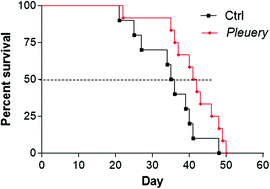JNK pathway and heat shock response mediate the survival of C26 colon carcinoma bearing mice fed with the mushroom Pleurotus eryngii var. eryngii without affecting tumor growth or cachexia
Abstract
In the last few years, there has been emerging interest in developing treatments against human diseases using natural bioactive content. Here, the powder of the edible mushroom Pleurotus eryngii var. eryngii was mixed with the normal diet of mice bearing C26 colon carcinoma. Interestingly, it was evidenced by a significant increase in the survival rate of C26 tumor-bearing mice accompanied by a significant increase in Hsp90 and Hsp27 protein levels in the tumors. These data were paralleled by a decrease in Hsp60 levels. The mushroom introduced in the diet induced the inhibition of the transcription of the pro-inflammatory cytokines IL-6 and IL-1 exerting an anti-inflammatory action. The effects of the mushroom were mediated by the activation of c-Jun NH2-terminal kinases as a result of metabolic stress induced by the micronutrients introduced in the diet. In the tumors of C26 bearing mice fed with Pleurotus eryngii there was also a decreased expression of the mitotic regulator survivin and the anti-apoptotic factor Bcl-xL as well as an increase in the expression levels of Atg7, a protein that drives autophagy. In our hypothesis the interplay of these molecules favored the survival of the mice fed with the mushroom. These data are promising for the introduction of Pleurotus eryngii as a dietary supplement or as an adjuvant in anti-cancer therapy.



 Please wait while we load your content...
Please wait while we load your content...